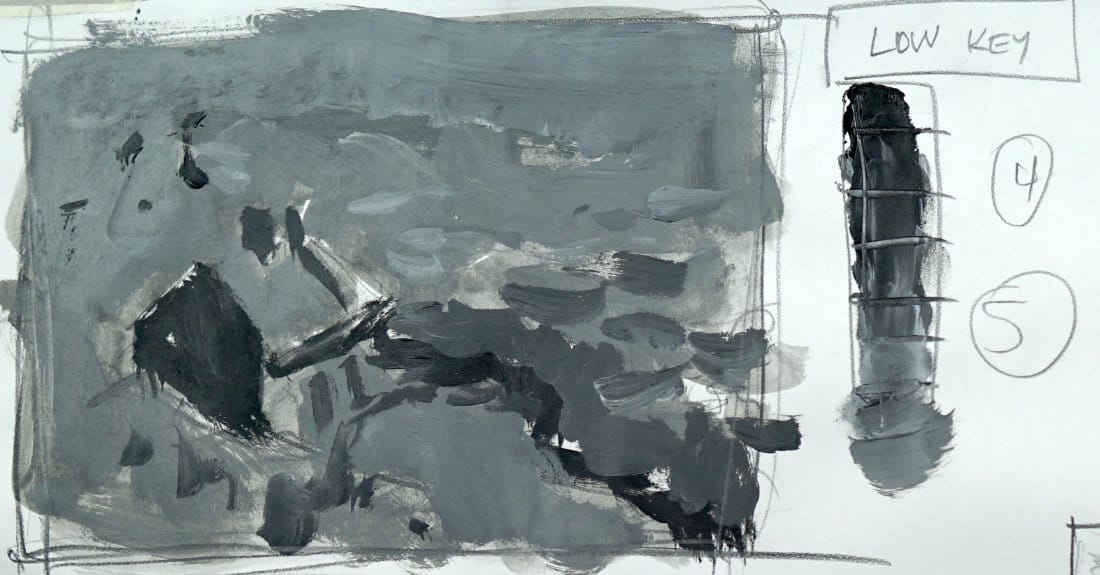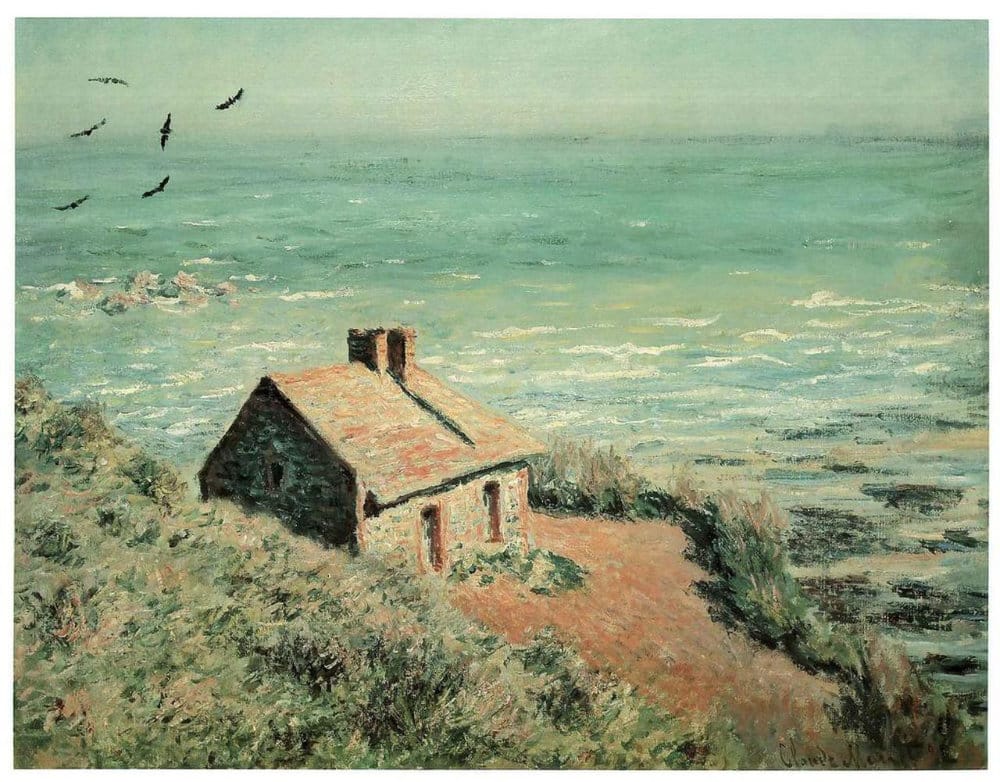Low Key Value Painting - Learning from Monet's Landscapes
Learn low-key value painting from Monet's landscapes. Discover how to compress value ranges into darker tones for dramatic, moody atmosphere in your landscape paintings.

Learn low-key value painting by studying Monet. Dark, moody landscapes with limited value ranges.
This is how masters created atmospheric depth with restraint.
This lesson is part of the Acrylic Landscape Painting Fundamentals Course - Section 2: Value Hierarchy.
What Is Low Key?
Low key = working in the darker value range.
Instead of using the full 1-10 value scale, you limit yourself to values 1-5 (maybe 6).
The result? Dark, moody, dramatic landscapes with rich atmosphere.
High key (next lesson) is the opposite - light, airy paintings in the 5-10 range.

Why Monet?
Monet was famous for variation within a mass.
Look at his cottage-by-the-sea painting. So many color variations:
- Teal water
- Warm shore grasses
- Pink cottage roof
- Green-gray sky

But when you desaturate it to grayscale? Everything merges into similar values.
That's the secret.
The Beginner's Failure
Inexperienced landscape painters see all those beautiful color variations in nature and throw colors down without considering value.
They don't realize: Every color has its own value.
- Bright yellow = high value
- Deep blue = low value
- Red-orange = mid value
Experienced painters understand this. Beginners don't.
Desaturate to See Structure
Take your Monet reference. Desaturate it to grayscale.
Suddenly, all those intricate color changes merge together. They're very similar in value.
The color created variety. The value created structure.
That's what you need to learn.
Creating the Low Key Study
For this Monet cottage scene, I'm working in the darker value range:
- Darkest darks = pure black (value 1)
- Lightest lights = mid-gray (value 5, maybe 6)
Everything stays in that compressed darker range.
Massive Unified Blocks
When you squint at the Monet, what do you see?
One massive block of value:
- Sky merging into water
- Water into shore
- Shore into cottage walls
- Walls into roof
Yes, there are gradations. But the bulk of the painting is one unified mid-dark value.
Only the darkest accents (cottage shadows, chimney, door) break darker.
The Low Key Hierarchy
For this painting:
- Value 1-2: Darkest shadows (cottage door, chimney, deep grass shadows)
- Value 3-4: Main landscape mass (sky, water, shore, cottage)
- Value 5: Lighter accents (waves, roof highlights)
That's it. 4-5 values total.
Everything pushed to the darker range.
Variation Within the Mass
Here's where Monet excels: variation within unity.
That huge mid-dark mass (value 3-4) isn't flat. It has:
- Gradation from sky to water
- Texture in the grasses
- Warmth in the shore
- Coolness in the water
But it all stays within the same value family.
When you add color later, those variations become obvious. But the value structure stays simple.
Color Separates What Value Unifies
In the color version:
- Sky = neutral gray-blue
- Water = teal-green
- Shore = warm ochre-orange
- Cottage = pink-orange
Color creates separation. But look at the grayscale? They're all similar values.
This is advanced thinking. Value creates structure. Color creates variety.
Why Low Key Works for Moody Landscapes
Low-key paintings feel:
- Dramatic
- Atmospheric
- Moody
- Rich
- Intimate
Perfect for:
- Stormy skies
- Dawn/dusk scenes
- Foggy mornings
- Dense forests
- Shadowy interiors
You create drama by limiting your value range, not expanding it.
Pushing Everything Darker
In a low-key study, you intentionally push everything darker than reality.
That bright cottage roof? Make it mid-value.
That light sky? Make it mid-dark.
You're compressing the entire scene into the darker range.
This feels counterintuitive, but it creates powerful atmosphere.
The 4-5 Value Simplification
Even complex Monet paintings can simplify to 4-5 values in a low-key study:
- Main unified mass (sky-water-shore-cottage)
- Darkest darks (shadows, accents)
- Lighter accents (waves, highlights)
- Maybe one more mid-value for separation
That's all you need.
Masters worked with restraint. So should you.
What You Learn from This
By creating a low-key Monet study, you discover:
- How to compress value ranges
- How color variations can share similar values
- How to create drama with restraint
- How massive unified value blocks create cohesion
- How variation within a mass adds interest without breaking structure
This is advanced landscape thinking.
Next lesson: High key (the opposite approach).
Course Navigation
Next Lesson: Value - High Key Demo with Monet - Light, airy landscapes
Previous Lesson: Common Value Mistakes - Avoid choppy results
Course Hub: Acrylic Landscape Fundamentals
Learn & Improve Your Acrylic Skills
- Acrylic Hub– Your go-to guide for tutorials, tips, and resources.
- Ultimate Beginner Acrylic Course - Start painting with confidence.
- Subscribe for More Great Content - Get tutorials, tips, and updates straight to your inbox.
- Follow Me on Pinterest - Daily inspiration, tips, and fresh ideas.
Recommended Acrylic Painting Materials
-
Princeton Catalyst Brushes – Flats (#6, #12), Rounds (#4, #8), Fan (#4), Liner Brush
Durable synthetic bristles for versatile acrylic techniques -
Liquitex Heavy Body Acrylic Paint – Essential Colors
Cadmium Yellow, Yellow Ochre, Alizarin Crimson, Cadmium Red Light, Ultramarine Blue, Cobalt Blue, Burnt Sienna, Titanium White -
Winsor & Newton Cotton Canvas
Reliable stretched canvas for studio and plein air work -
Strathmore 400 Series Mixed Media Paper
Heavyweight, acid-free paper for acrylic and mixed media -
Fabriano Artistico 140lb Cold Press Paper
Excellent for acrylic, mixed media, and textured effects -
Blick Multi-Colored Painting Knife Set
Variety of shapes for texture, scraping, and bold strokes - Miscellaneous: Two pint-sized water containers, paper towels (from Home Depot or Walmart)
- Note: I use canvas or sturdy cardboard as my palette — no store-bought palettes needed.




